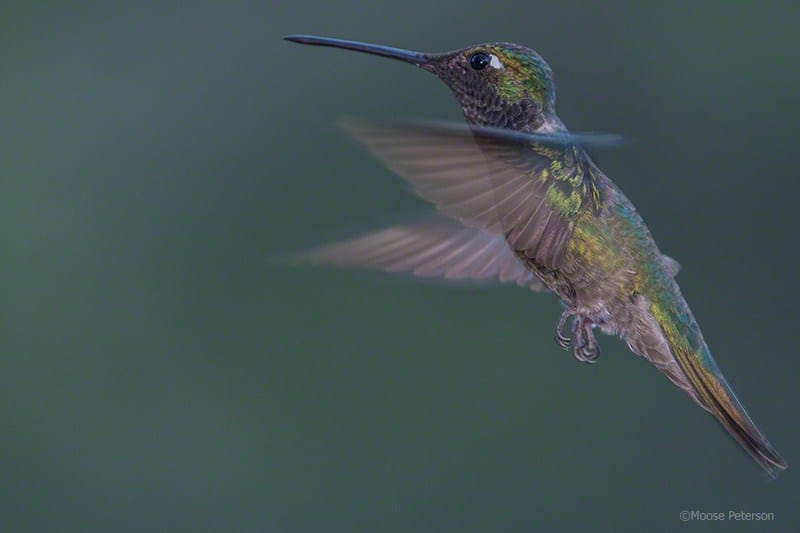We were so fortunate last week to spend it in the company of some great shooter and amazing birds. That combination should have produced some killer images. It was on paper the perfect mix of biology and technology, hummers and flash.
Madera Cyn, Santa Rita Lodge, in particular, is simply a spectacular location for birds, specifically hummers. With that biology, today’s iTTL technology is the perfect tool for produce the images we were after. We should start there, the image we were after.
There are definitely two camps when it comes to Hummer photos, frozen wings, and blurred wings. After seeing my aviation work and the blurred props, it’s no coincidence I’m in the blurred wing camp.

It’s simple, I experience hummers as this blurred jewel and that’s how I want to tell their story in my photos. And that’s where this all begins, the subject and the story I want to tell.
What makes hummers so darn cool? Their hovering abilities and the amazing colors they bring to our world. The key to bringing this to life is flash. There is a simple rule in photography regarding light … The angle of incidence equals the angle of reflection. This rule is very angular, straight line but our subject is anything but flat!
The curve of the hummingbird gorget, throat, is very curved so if we use a flash by itself, we end up with just one specular highlight or one spot on the neck with color. To overcome this rule of physics, we used two SB-5000s each with a Rogue FlashBender 2 small. As you can see below, they are attached together and curved.
With this, you can light up the entire throat of the hummer and the light bounces back with all the color to the film plane. Easy peasy! There is just one little flaw in this whole light, hummer, success theory!

captured by D500 / 300PF / SB-5000 rig

D500 / 300PF / 2x SB-5000 / SD-9
The technology worked great. The main rig was the D500, 300PF, 2x SB-5000s (with SD connected) with the 2 Rogue. Shooting using the Autoarea AF in the D500 along with wireless WR-R10 iTTL made the technical pretty simple. The 300PF with its fast focsuing and MFD was the perfect lens to use for this challenge.
More importantly, this very small, totally portable rig took the hassle out of big lights, boxes and expense out of the picture. And with the ease came the fun! The hitch to all this great theory is the person behind the camera and the bird in front of it. As you can see in the Magnificent photo at the top, when the Hummer was facing into the lights, he lights up like neon. But when he doesn’t face into the lights, the rule of light means we see only black neck.
So, what went wrong? The fault is all mine, the person behind the camera and not the theory or the technology but rather the execution. Control in wildlife photography is a myth but we can slant things in our favor. In this case, the hummer was able to feed on the side flowers on the feeder. By not placing tape on them, the hummer could come and go sides ways rather than in from the back which would have made them face the lights (like in the top photo).
Now can this all work? Oh hell ya, just take a look at what Carol captured with the same rig, same hummer, gorgeous! So what does this all mean? It means I will spend more time working on my end of the deal, the person behind the camera and I will be heading back again next summer to Madera to put it into practice! Because where it has to look great in the photo, all the light melded together to show off these flying jewels. It doesn’t count if it jsut looks great on paper!
Note: Many have asked for my settings in doing this. Knowing that info is useless as the ambient light always changes, the flash to subject distance fluctuates and most importantly, how we meld light will always be different. If you want to find out the settings for you, set up your rig and photograph a red xmas ball in various light and then you will have your numbers for YOUR photography.
Moose Peterson
Moose’s true passion has always been and remains photographing the life history of our endangered wildlife and wild places. Since 1981 he and his wife Sharon have dedicated their lives to this pursuit. Educating the public about our wild heritage is their hallmark. In recent years Moose has added aviation photography to his pursuits with the same goal of preserving our aviation heritage, pictorial and oral for future generations. Along the way Moose has been honored for his photographic passion: a Nikon Ambassador USA, Lexar Elite Photographer, recipient of the John Muir Conservation Award, Research Associate with the Endangered Species Recovery Program, just to name a few. He’s part of Epson’s Finish Strong ad campaign. Moose is creative producer/photographer of his acclaimed film: Warbirds and The Men Who Flew Them. He shares his knowledge through his writing, being published in over 143 magazines worldwide, author of 28 books including his latest, Photographic FUNdamentals, Taking Flight and best seller Captured. He lectures across the country to thousands upon thousands of photographers every year. One of the original Nikon shooters to receive the D1 in 1999, Moose embraced this new technology, becoming the only wildlife photographer in the world to shoot strictly digital in the early years. While a beta site for all the major hardware and software manufacturers, Moose continues being a creative innovator of new techniques both behind the camera and the computer, which is the driving force behind his photography and goals.
- Web |
- YouTube |
- More Posts(8)
Leave a Reply